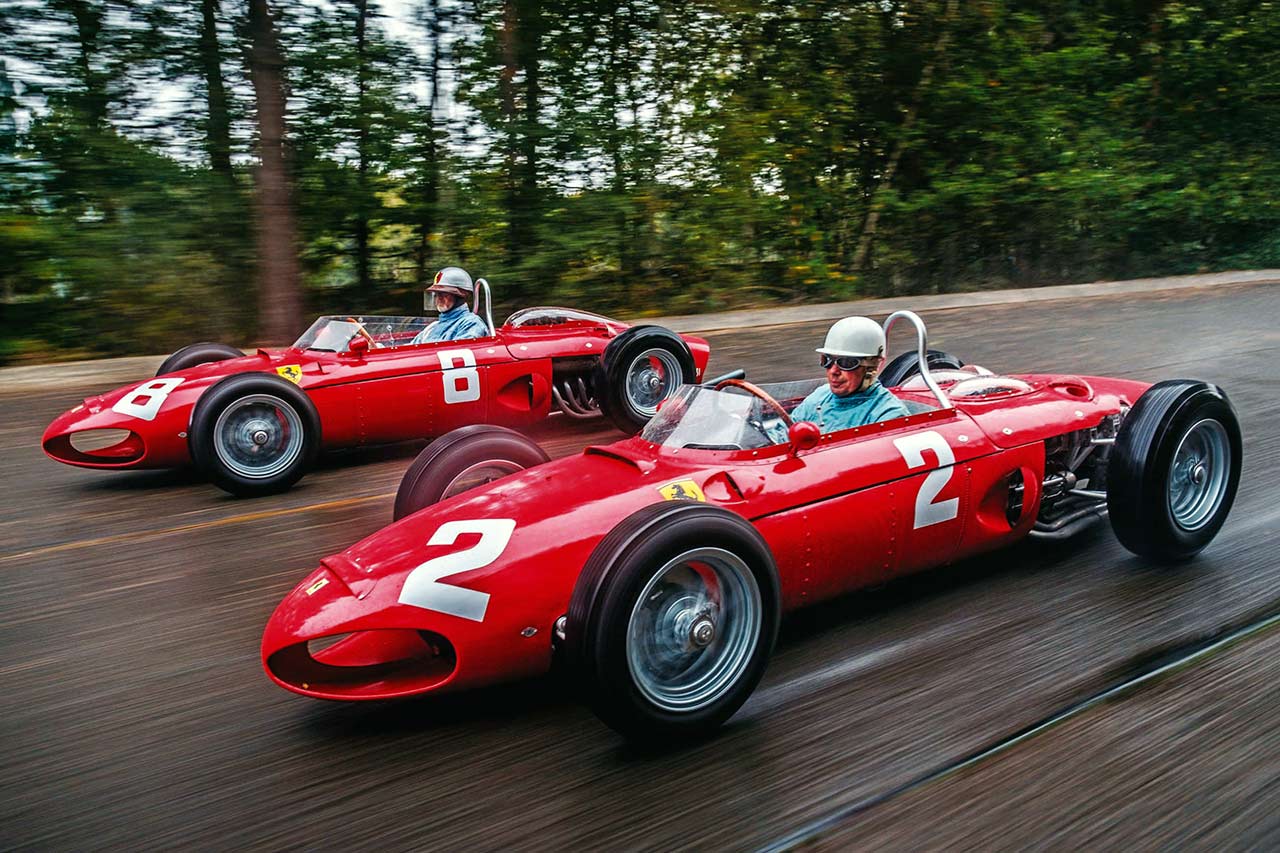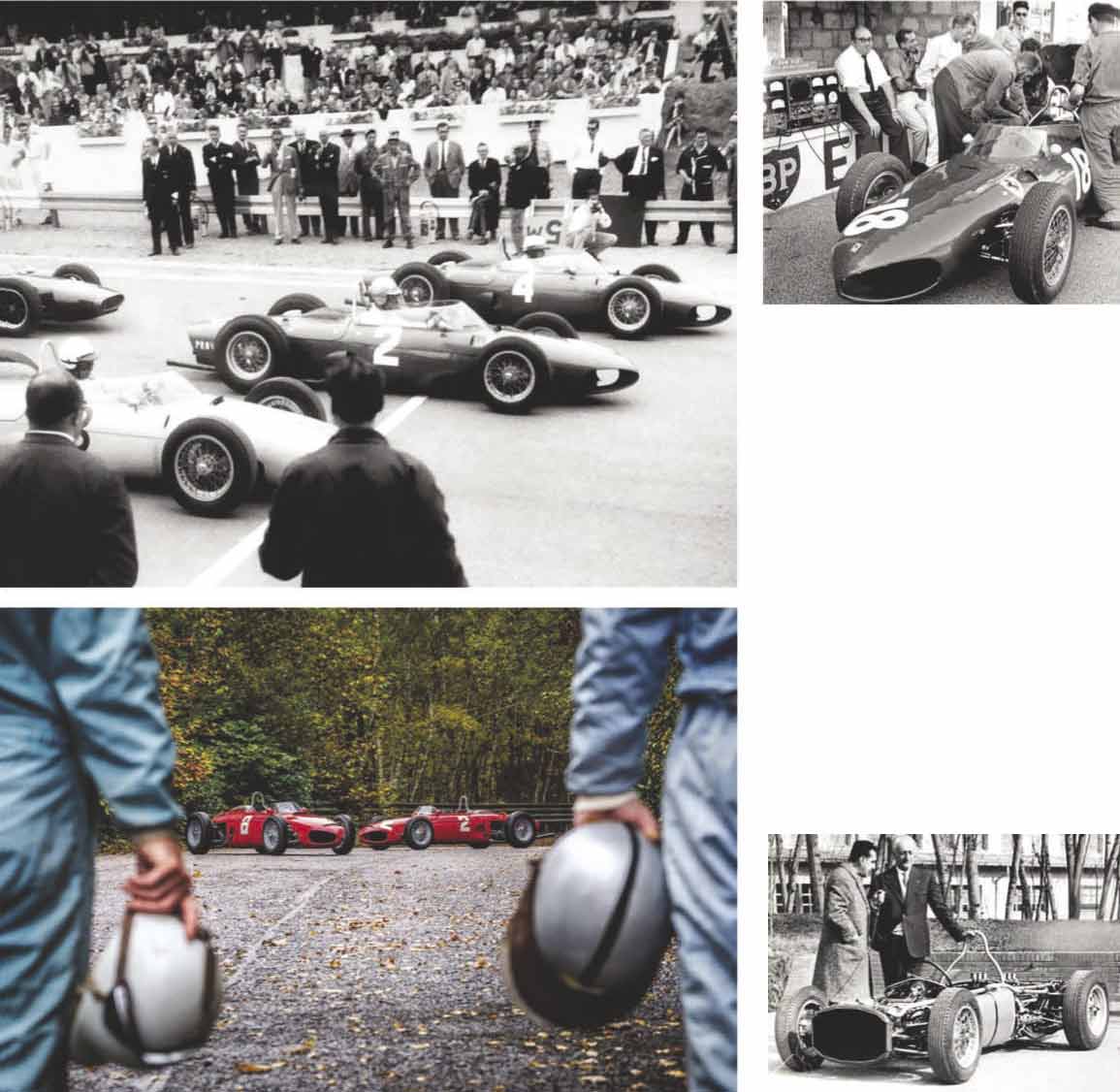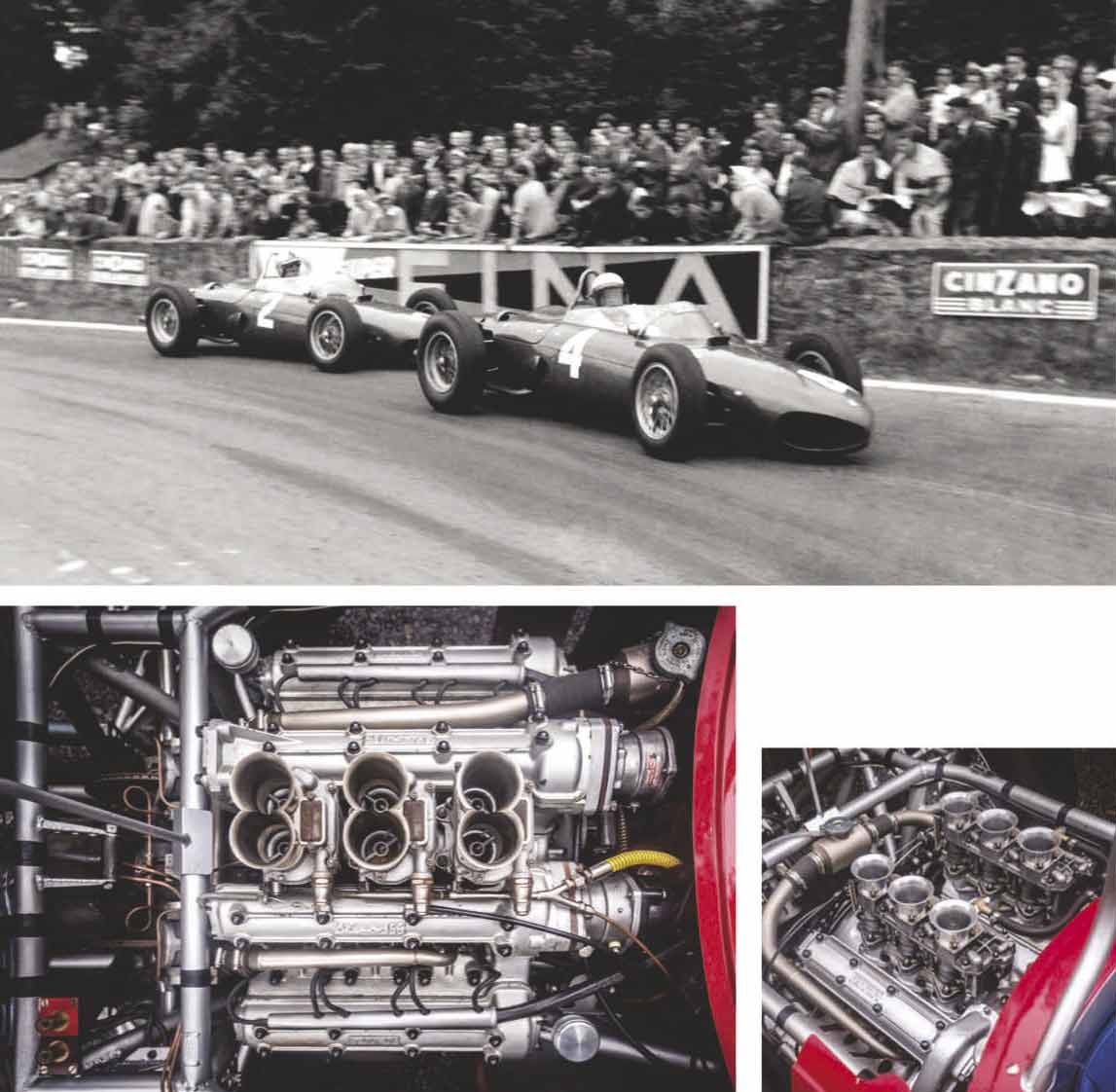
Craftsmanship in action, as stunning Ferrari 156 pair returns to the track. ‘Sharknose’ duo reborn. Mick Walsh gets a dream drive in a pair of Ferrari 156 Grand Prix cars. Fable of the Reconstruction Mick Walsh sets the time machine to 1961 to revel in an exclusive drive of two exactingly rebuilt ‘Sharknose’ Tipo 156 Ferraris around a rain-soaked track. Photography Dirk De Jaeger.
It could be a wet Aintree or the Nürburgring in 1961, the season that the famous ‘Sharknose’ Ferraris dominated Grand Prix racing. Rooster tails spray up from the Borrani wires as two V6-powered machines splash through the puddles around a timewarp, tree-lined test track. Driving one of Maranello’s first rear-engined challengers would have been special enough, let alone running in company with a sister car, twin exhausts emitting that distinctive V6 yowl as the three-eared spinners whizz around within touching distance. Kitted out in period helmets and overalls, it just couldn’t get more evocative as we jostle for position and swap places.

I try to take it all in as the rain and spray become more intense, blurring my visor. The pace and drama aren’t close to the tense 1961 Championship year, but driving these remarkable reborn racers is as authentic as it can get.
Specialist Mike Mark, who was a key player all through this amazing project, and lucky me feel as if we’ve been transported back. The vivid experience is intensified by the vulnerability of the exposed seating between the tanks, with no belts and hopeless roll-over hoop, the super-responsive controls and the eager power of these 1½-litre legends. All those fascinating old photos of Phil Hill, ‘Taffy’ von Trips and Ritchie Ginther suddenly take on another dramatic dimension.
The steering via the broad, wood-rimmed three-spoke Nardi wheel is quick and direct, which must have been a revelation after the more muscular 246 Dinos. The combination of the mid-mounted engine, novel forward seating, plus a close view of the front wheels and working suspension, must have taken adjustment, but all the drivers soon adapted to its fine balance out of the box. Hill rapidly attuned to the neutral handling. Whereas his front-engined Dino constantly snapped from under to oversteer, the Tipo 156 was like “control-line flying with no one cutting the string”. The Sharknose seems sharp, too, with a little steering kickback over bumps, but everything quickly settles.
The gearchange is set down to the right with a short, stubby lever within a five-speed gate. With its closely stacked ratios and slick action, the shift feels neat and really modern. Drivers experienced selection dramas on twistier tracks such as the ’Ring and Zandvoort, but historic racing specialist Dan Setford reckons that this was related more to chassis flex rather than transaxle faults. When a Tipo 156 was loaned to the UDT-Laystall équipe for Innes Ireland to drive in the International Trophy at Silverstone in 1962, the Scottish ace rated the Ferrari gearbox “a dream” and the “best experienced in a racing machine”. The Dunlop disc brakes – outboard at the front and inboard at the back – are strong, with the light pedal action providing reassuring response, although many of the team reported a tendency to lock at racing speeds, plus an abrupt dive with the nose almost touching the track.
But it’s the V6 engines that are the highlight of these 1961 champions. Both the 65º and 120º V6s really want to rev, though it’s the wider-angle engine that feels more aggressive. It’s rougher through the range, but it punches stronger at the top end and begs to be held longer and longer in each gear. Drivers were regularly castigated for over-revving engines, and former team manager Romolo Tavoni later told owner Jason Wright that mechanics would report telltale needles as high as 13,000rpm. “Your right foot is definitely attached to your smile,” enthuses Setford, “and I’d love to see someone really confident have a go in the 120º V6 car.” Nothing could match Ferrari for power in 1961, with the ultimate wider-angle engine producing 190bhp compared to 180bhp for the smoother 65º motor.
It is impossible to push the handling during our wet test, but they feel beautifully balanced. In 2012, Dutch former F1 star Jan Lammers was invited to race Jan Biekens’ Sharknose recreation, on which one of these cars is based. Despite no testing, and driving without a seat, he started from the back of a pre-’1965 HGPCA grid, and stormed through the field to finish 10th. “Jan loved the car, particularly the precise feel,” recalls Setford. The second Sharknose, with lighter, wider-angle engine, had a lower centre of gravity and handled even better claimed drivers. Compared to its less-powerful four-cylinder Cooper and Lotus rivals, the longer-wheelbase Tipo 156 looked the heavier car.
Contemporary images reveal acute negative camber at the rear because designer Carlo Chiti placed great emphasis on suspension geometry, with several options for settings to match the track demands. The engineers were continually playing with camber angles and tyre pressures throughout the ’1961 season, but the Tipo 156 never looks out of shape in archive pictures – other than on the broken surfaces of Monaco and in the severe heat at Reims. When they did let go – particularly in the wet – the low polar moment meant that the cars swapped ends very quickly, as Hill discovered at Aintree.
Having been fascinated by Sharknose Ferraris since my childhood, after getting the Corgi miniature with its bold 36 race numbers, I have enthusiastically applauded the rebirth of these V6 icons. After the disappointing 1962 season – when the red racers were outgunned by the more advanced British lightweights and more powerful V8s – Enzo amazingly ordered the GP Sharknose racers to be broken up, with rumours they were encased in the concrete factory foundations. It seems amazing that a championship winner could take such a dispassionate attitude.
The total lack of survivors has fuelled the imagination of enthusiasts – none more so than rock musician Chris Rea, who had a lookalike 156 built for a musical project inspired by his childhood fixation for the Rhineland nobleman ace Count Wolfgang ‘Taffy’ von Trips. Even ’1961 World Champ Hill was tempted to demonstrate the film prop at Goodwood, but it was Belgian Biekens who took things to another level.
Having discovered an original 65º V6 and gearbox, in 2004 Biekens began planning a new replica based around the genuine parts. After sourcing factory chassis drawings, he commissioned Jim Stokes to recreate Olivier Gendebien’s Ecurie Nationale Belge 156 (as raced at Spa in 1961). A determined global search uncovered more parts and, after five years’ work by Stokes’ expert craftsmen – more than 9000 hours, not including bodywork – the yellow sensation made its debut at the 2009 Goodwood Revival, where Biekens realised his dream at the wheel. As the car was developed, Biekens raced it at Spa and Silverstone, but he unexpectedly decided to sell it once he had achieved his goal. The homage was immediately acquired by American historic racer and lifelong Phil Hill fan Jason Wright.
One of the conditions of the sale was that the yellow 65º Sharknose would remain on exhibition in the Ferrari Museum at Maranello for a further six months. In the meantime, Wright sourced as many photographs as possible to prepare for the project. While he was studying images and scaling up dimensions from the ’1961 season, Wright came to the conclusion that the recreated bodywork wasn’t right. Amazingly, a blueprint of the factory drawings then turned up – something that even Maranello didn’t have – and this confirmed the inaccuracies.
Although the body commissioned by Biekens had been superbly made by Vintage Cars of Lymington in 2007, Wright was set on creating a more accurate profile and appearance. Rather than use an English wheel, he felt that the new shell should be made using traditional methods, shaping the aluminium around a wire frame with hammers. That would give a rippled, handformed finish, as fabricated in the first place by the artisans at Carrozzeria Fantuzzi in Modena.
Roach Coachworks, famed for its Auto Union and Mercedes-Benz Silver Arrows recreations, was enlisted to make the bodies but instructed to use back-to-basics techniques. With the chassis stripped of panelwork, it also became clear that modern TIG welding was too neat and tidy.
“It looked more like a fine model rather than an old Ferrari,” says Wright, “so we decided to construct a new frame and suspension using oldstyle gas welding.” If you study Ferrari workshop images, the crude ‘blobby’ welding is very clear. As Setford recalls: “Our welder Pete, with his gas torch, little visor flicked up and cigarette on the go, even started to look like a 1960 photograph.”
Many components from Biekens’ replica were re-used, including the instruments, brakes, radiator, springs, dampers and pedals, plus the factory engine and gearbox, but the rest was reconstructed. European metric tubing was ordered for the fresh chassis, while the fuel and oil tanks were remade using proper Italian rivets. Ruote Borrani Milano sourced the Ferrari drawings for the Tipo 156 rims (it was the last Grand Prix car to win a World Championship on wires) and new wheels were made up.
The next major development was the acquisition of a second engine, better still a 120º V6 that powered the Sharknose to key Grand Prix victories during that dominant ’1961 season. The unit came from the estate of renowned French Ferrari collector Pierre Bardinon and, numbered 002, it coincidentally matched Hill’s chassis as driven to victory at Monza on that grim Saturday, 10 September. After the American demanded an engine change before the race, Hill’s Ferrari was the only one of the five entered that finished. Wright also had an original gearbox, so the prospect of a companion wide-angle V6 Sharknose became realistic. Without these key components, it would have required prohibitive costs. A decision was made to recreate two cars from the Monza GP, Hill’s Championship winner and, with the 65º motor, chassis 006 in which the young Mexican hotshoe Ricardo Rodríguez made his historic Grand Prix debut. Among the challenges for completing the 120º engine were the missing carburettors.
“We could have easily used a set of triple-choke downdraught Webers – as fitted to a Porsche 911 or a Lamborghini Miura,” says Wright, “but although they matched the specification, the casting looks very different.”
Ever the perfectionist, he first made an approach to the Museo Nazionale dell’Automobile, but the Turin facility proved unwilling to cooperate. Cité de l’Automobile, however, formerly the Schlumpf Collection, couldn’t have been more helpful: “The Mulhouse museumhas a 1963 Ferrari Tipo 156. Although its Webers are incorrect for the later engine, they were perfect castings to copy for our V6.”
The French museum director couldn’t have been more accommodating, and even agreed to loan the complete car to Setford & Company for three months. No doubt an introduction from Maranello helped, explaining that Wright was not replicating something that already existed, but a lost Championship-winning car.
‘You have the engines, they were only made for a Grand Prix car,’ encouraged the letter from the factory. ‘It would be a shame not to see and hear them run.’ As well as helping to remake the missing Webers, the loan of Tipo 156 B 004 also gave Setford’s team a chance to carefully study the construction and finish – including the welding technique, clips, fasteners and many other items that further added to the sympathetic detailing of the reborn pair of Sharknose racers.
With the new bodies fitted, the two bare-metal single-seaters – with dappled hammer marks – looked like rolling sculptures, and almost too good to paint. Determined to retain that handmade finish, Setford’s team avoided filler to smooth the finished shells, and enlisted Chris Arnott to spray the chassis and bodywork in his home garage. With none of the faked distressed ageing that’s become a fad in restoration, the two scarlet machines looked just as they would have done when rolled out for a Grand Prix in 1961. With the fast-approaching deadline of the Festival of Speed Ferrari celebrations, the team at Bushy Down Farm worked all hours last June.
The closing stages brought together a wealth of talent, including Argentinian designer Gabriel de Meurville who was enlisted to produce the graphics for the final detailing. The bold, distinctive race numbers – 2 for Hill, and 8 celebrating Rodríguez – were accurately scaled and positioned, while de Meurville painted the PROVA letters on the sides of the tail and positioned the Scuderia Ferrari shields. On the evening before delivery to Goodwood, the two V6s barked into life, the sweeter 65º unit contrasting with the sharper howl of the more powerful 120º motor. It was a special moment as they revved up for a test, the two engines unheard together for 55 years.
The Sharknose beauties were the talk of the prestigious Goodwood event, during which Ferrari personnel and works mechanics regularly visited Setford’s pit to view the cars. The highlight came when Phil Hill’s son Derek joined former Maranello works driver ‘Little Art’ Merzario to drive the exquisite machines in formation up the Goodwood hill, which made all of the long nights worthwhile for the crew.
Plans for selected outings for the Sharknose single-seaters this year include the new 500Km of Imola Revival Motor Legend Festival from 20-22 April and the Zandvoort Historic GP from 31 August to 2 September – both with Hill and Merzario driving. Back at Setford & Co, though, the gifted craftsmen are now focused on a matching 246SP to go with the GP pair to complete this remarkable recreated set.
Thanks to Jason Wright; Roach Manufacturing (http://roachmanufacturing.com); Setford & Company (www.setfordandcompany.co.uk)
Tech and photos
TECHNICAL DATA FILE SPECIFICATIONS 1961 FERRARI TIPO 156
Number built nine, including prototype
Number tubular spaceframe chassis with aluminum bodywork
Engine all-aluminium 1496.43cc 65º or 1476.60cc 120º V6, with Duplex chain-driven dual-overhead camshafts and two valves per cylinder, four main bearings, and dry sump; three downdraught Weber 42DCN carburettors; (two special triple-choke 40IF3Cs on 120º unit); twin-plug ignition with two Marelli distributors
Bore & stroke 81 x 48.2mm (65º); 73 x 58.8 mm (120º)
Max power 180bhp @ 10,500rpm (65º); 190bhp @ 9500rpm (120º) / DIN
Transmission five-speed manual transaxle, with clutch mounted at back, driving rear wheels via a limited-slip differential
Suspension independent, by unequal-length wishbones, coil springs, Koni telescopics
Steering rack and pinion
Brakes Dunlop discs, inboard at rear
Length 15ft 1in (4060mm)
Width 4ft 7in (1400mm)
Height 3ft 3 2/5 in (1000mm)
Wheelbase 7ft 6 ½ in (2300mm)
Weight 970lb (440kg)/926lb (420kg, 120º)
Fuel 75 litres in each side-mounted tank
Wheels/tyres 5.50x15in (f), 6.00 x 15in (r)
Top speed 163mph (260kph)



‘YOU HAVE THE ENGINES… IT WOULD BE A SHAME NOT TO HEAR THEM RUN,’ ENCOURAGED MARANELLO’S LETTER’
‘IT JUST COULDN’T GET MORE EVOCATIVE AS WE JOSTLE FOR POSITION AROUND THE TIMEWARP TEST TRACK’
Sharknose stories
Few knew the ’Ring as well as American Phil Hill, who confirmed his brilliance at the ‘Green Hell’ in the 1961 German GP when he strung together a near-perfect 8 mins 55.2 secs practice lap. Faster than his team-mates by 5 secs, Hill’s staggering time was the first ever sub 9-minute lap, for which he was awarded a ceramic tea set and a silver tray. But Stirling Moss outfoxed the Ferrari team again to win the wet thriller with his lighter Lotus-Climax 18.
The distinctive nostril style is credited to Carlo Chiti. Like many Italian engineers, his background was in aeronautics and he set up Ferrari’s first in-house wind tunnel. Using old four-pot race engines to power the fans, Chiti proved that the nose improved aerodynamics. The Sharknose’s origins, however, came from a trio of Maserati 250Fs bodied by Medardo Fantuzzi using sketches by Hans Tanner.
Giancarlo Baghetti joined an elite group by winning his debut GP at Reims in a gripping slipstreaming classic on one of the hottest days of the year. The wealthy junior, driving a loaned 65º prototype 156 run by Federazione Italiana Scuderia Automobilistiche, outlasted the works drivers. Baghetti also gave the Sharknose its maiden victory in a non-Championship race, at Syracuse, Sicily on 25 April, and again a few weeks later in Naples, but his career never matched that hat-trick.
Enzo played mind games with his star drivers all through ’1961, never nominating a number one. Hill, von Trips and test driver Ginther all had a chance to take the title. After Hill’s mistake at Reims, and failure to turn up for testing at Modena, Ferrari sent him a telegram stating he wouldn’t have a car for the British GP. Come race day, he relented. He’d also give young guns a try, including Ricardo Rodríguez at Monza, and chided his aces when the new kid was faster.

Von Trips’ poor start from pole at the Italian GP was partly due to the Ferrari’s high gearing for the ultra-fast Monza banking. This allowed Jim Clark’s quicker Lotus to get the jump, but Phil Hill was in front by lap two. He had no idea about the tragic consequences behind him, when Trips and Clark tangled at the Parabolica, until Tavoni told him as he walked up the pitlane as the new World Champion. After Ferrari cancelled its entry at the last round at Watkins Glen, Hill had to sit it out as a spectator.
The restoration: building a Sharknose
How a specialist fabricator went back to basics to construct a period-correct replica
Buck and tail, plus walls plastered with reference material. Keith Roach shaping the bodywork, just as the Italians did Oil and fuel tanks were made using authentic rivet style. Distinctive single bubble over carb trumpets of 65º V6. Original gearbox features multi-plate clutch behind ’box. Rear suspension wishbones incorporate extra bracing. Driver snug between two side-mounted 75-litre fuel tanks.







